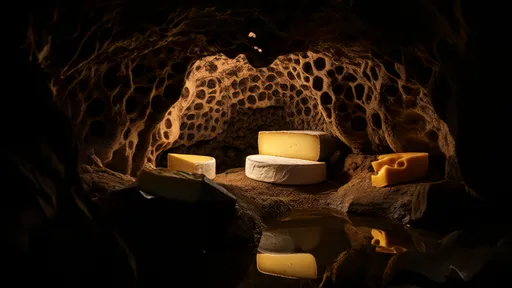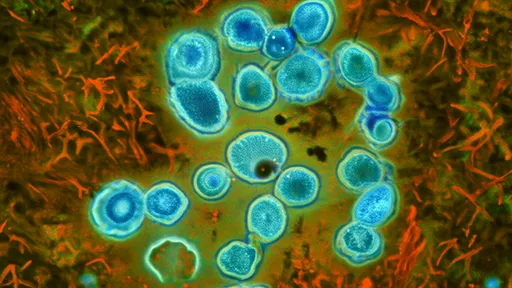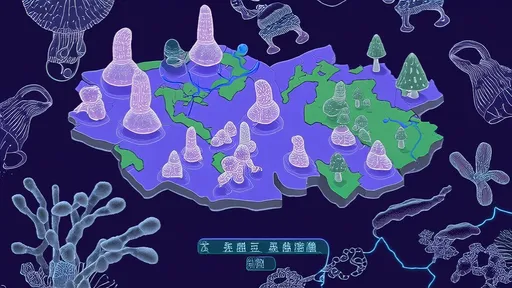Beneath the radar of human history, an invisible caravan of microbes has been crisscrossing continents for millennia. The emerging field of fermentation geography reveals how bacterial cultures have traveled along ancient trade routes, adapting to new environments and shaping regional cuisines in ways we're only beginning to understand. From the sticky strands of Japanese natto to the tart vegetal notes of Yunnan's sour moss, these microbial migrations tell a story more complex than any human chronicle.
The journey begins with Bacillus subtilis var. natto, the bacterium responsible for Japan's iconic fermented soybean dish. Recent genomic studies suggest this microbe didn't originate in Japan at all, but rather hitched rides on straw or rice shipments along the Silk Road. When researchers compared natto bacteria strains across Asia, they found striking genetic similarities between Japanese varieties and those found in fermented bean pastes from China's Yunnan province. This microbial kinship suggests a shared ancestry dating back to when these regions were connected through the Tea Horse Road, the lesser-known southern sibling of the Silk Road.
What makes this bacterial travel particularly fascinating is how the microbes adapted to their new homes. In Japan's humid climate with abundant soy agriculture, B. subtilis evolved to produce particularly viscous polymers - hence natto's characteristic stringiness. Meanwhile, in Yunnan's cooler highlands, related strains developed different metabolic pathways that contribute to the complex umami flavors of local fermented bean products. The same microbial "language" expressed itself in completely different dialects across geographical boundaries.
Yunnan's sour moss presents an even more intriguing case of microbial migration. This traditional fermented vegetable product, made from various mosses and leafy greens, relies on a complex community of lactic acid bacteria and yeasts that bear genetic markers tracing back to Southeast Asia. Researchers hypothesize that these microbial communities traveled north with monsoon winds carrying fungal spores, as well as through the movement of fermented fish products like pla ra from Thailand and Laos. The sour moss microbiome contains several bacterial strains that show remarkable genetic similarity to those found in Thai fermented foods, suggesting a microbial exchange that paralleled human trade networks.
Fermentation vessels themselves became unwitting arks for microbial dispersal. The porous clay pots used for centuries in Yunnan's fermentation practices have been shown to harbor bacterial communities nearly identical to those found in similar vessels from Korea's kimchi tradition. This points to a shared technological heritage where the very tools of fermentation served as vectors for microbial exchange, regardless of the ingredients being fermented. The microbes, it seems, cared less about national boundaries than about finding suitable ecological niches.
Climate played a decisive role in determining which microbes thrived where. Researchers mapping the distribution of fermentation microbes across Asia have noticed clear patterns correlating with temperature and humidity. The Aspergillus oryzae mold used in sake production, for instance, shows genetic adaptations that track precisely with Japan's seasonal humidity fluctuations. Meanwhile, in Yunnan's more temperate climate, related Aspergillus strains developed different enzymatic profiles better suited to local conditions. This microbial specialization helps explain why certain fermentation traditions flourished in specific regions while failing to take root elsewhere.
The implications of fermentation geography extend far beyond culinary curiosity. Understanding these microbial migrations could help preserve endangered fermentation traditions as climate change alters regional ecosystems. In Yunnan, where rising temperatures threaten to disrupt traditional sour moss production, researchers are working with local communities to identify microbial strains that might be more resilient to changing conditions. Similarly, studies of natto bacteria's historical adaptations may inform efforts to maintain Japan's fermentation heritage in the face of environmental shifts.
Perhaps most remarkably, these microbial journeys challenge our notions of cultural ownership of food traditions. The bacteria in your natto or the fungi in your sour moss likely have ancestors that traveled thousands of miles across centuries. In an era of heightened nationalism, fermentation geography reminds us that our most cherished food traditions are, at their core, the products of endless exchange and adaptation. The microbial world has always been globalized, long before humans conceived of globalization.
As research in this field continues, we're likely to discover even more surprising connections between distant fermentation traditions. Early studies suggest possible links between the microbes in Yunnan's fermented teas and those in Eastern European kvass, hinting at microbial exchanges along the entire length of the ancient Silk Road. Each new finding adds another thread to the intricate tapestry of microbial migration that has, quietly but profoundly, shaped human culinary history.
The next time you encounter a fermented food, consider the incredible journey its microbial cultures may have taken to reach your plate. From the steamy kitchens of Kyoto to the misty mountains of Yunnan, these microscopic travelers have been weaving connections between human communities long before air travel or the internet. In studying their movements, we don't just learn about bacteria - we uncover forgotten chapters in the story of human interconnection.

By /Jul 16, 2025

By /Jul 16, 2025

By /Jul 16, 2025

By /Jul 16, 2025

By /Jul 16, 2025

By /Jul 16, 2025

By /Jul 16, 2025

By /Jul 16, 2025

By /Jul 16, 2025

By /Jul 16, 2025

By /Jul 16, 2025

By /Jul 16, 2025

By /Jul 16, 2025

By /Jul 16, 2025

By /Jul 16, 2025

By /Jul 16, 2025

By /Jul 16, 2025

By /Jul 16, 2025